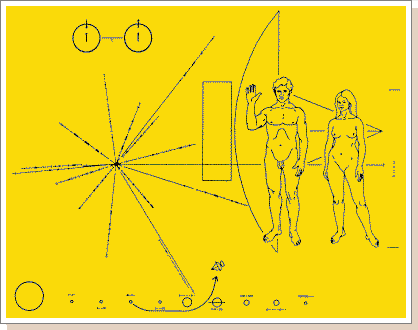
Two missions have sent probes to the outer solar system, - Voyager and Pioneer 10. Your task is to answer some questions about these missions.
1. How far (in AU's) from the sun is each probe currently (please give the
source of your data).
Voyager was actually two probes - Voyager 1 & Voyager 2.
Both Voyager probes are well over 100 AU from us (real time data -
Voyagers)
Pioneer 10 lost signal in 2003 at a distance of 80 AU
2. Are either probe still in operation and sending data back to
earth? If so, how much power do they emit? What is their power
source?
Pioneer 10 is dead, but we are still receiving data from
the Voyager probes. The cameras are turned off but it still has enough
power to transmit until the mid 2020's. At launch, both probes produced
470 w of 30 volt DC electrical power. To put this in layman's terms, this
is the power output of a light bulb. However, since the power comes from
the heat produced by the radioactive decay of Plutonium, the power levels have slowly dropped over
time. This mandates that systems must be turned off, one-by-one, until the
power levels drop to zero.
3. A few years back, Voyager discovered something called the
heliopause (or heliosheath). What is that? What defines both sides
of this area? It also discovered something called "Local Fluff".
What is that? Where did it come from? What holds it together?
There comes a place (heliopause) when the probe is no longer influenced
by the sun but, rather, interstellar space. For example, in 2013 Voyager 1
reported a steep drop in the solar wind (charged particles emitted by the sun)
and a corresponding increase in galactic cosmic rays (ultra fast particles from
outside the solar system known as the interstellar wind). Along with
a sharp rise in the plasma density told astronomers that Voyager has reached
interstellar space.
The Voyagers discovered an unexpected cloud of hydrogen and helium (called Local Fluff) left over from supernova explosions that occurred over 10 million years ago. Voyager discovered a strong interstellar magnetic field which helps hold this cloud of gas together.
4. Pioneer 10 had a plaque on it to tell aliens a bit about us (a bit like throwing a letter in a bottle and tossing it into the sea).

Pioneer Plaque
This plaque is suppose to tell aliens the location of the sun (as well as the height of humans). Exactly what was the strategy in encrypting this information? It is unlikely they all know English as they did in Star Trek.
Carl Sagan and Frank Drake designed this plaque as a way to tell any alien about us. It has an image of a naked male and female next to the spacecraft itself (to give scale). Along the bottom it shows that the probe was launched from the 3rd planet in system (they still counted Pluto as a planet then). At the middle left, it shows how far our sun is from the closest pulsars (by the length of the lines). It also has numbers associated with everything to indicate exact distances and time.
Distance: The way this works is by looking at the very top left to see the key - the hydrogen atom. It shows two hydrogen atoms with electrons with opposite spins ... and the number ONE imprinted (in binary) between them. Any alien would know that hydrogen emits a wave of 21 cm when the hydrogen atom flips the spin state. However, they would not understand what a centimeter was. This was the key ... inventing a unit length anyone could understand. That is 21 cm = 1 unit. All other numbers are based on that standard ... written in binary code (we can not assume they have ten fingers and count with base 10). Binary only uses zeros and ones .. the simplest way to count. As a check, the aliens could easily read the number stamped for the dimensions of the spacecraft and know they got it right. Very clever!
Time: The transition of hydrogen is also associated with a unit of time - .7 nanoseconds. This becomes 1 unit of time in binary notation. The pulse rate of 14 pulsars are expressed in binary. Any alien would be able to locate these pulsars and (based on reasonable rates of decay), be able to tell WHEN the probe was launched.
Now the questions become .. was this a wise thing to do???? Do we want to tell aliens where we are? Can we assume aliens are benevolent? Many have argued that it is unwise to announce our presence to a potential threat. What do you think?